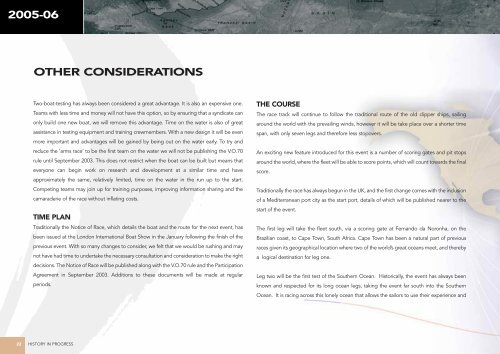Volvo Ocean Race: Overview, Marketing, History
Volvo Ocean Race: Overview, Marketing, History
Volvo Ocean Race: Overview, Marketing, History
Create successful ePaper yourself
Turn your PDF publications into a flip-book with our unique Google optimized e-Paper software.
2005-06<br />
OTHER CONSIDERATIONS<br />
Two-boat-testing has always been considered a great advantage. It is also an expensive one.<br />
Teams with less time and money will not have this option, so by ensuring that a syndicate can<br />
only build one new boat, we will remove this advantage. Time on the water is also of great<br />
assistance in testing equipment and training crewmembers. With a new design it will be even<br />
more important and advantages will be gained by being out on the water early. To try and<br />
reduce the ‘arms race’ to be the first team on the water we will not be publishing the V.O.70<br />
rule until September 2003. This does not restrict when the boat can be built but means that<br />
everyone can begin work on research and development at a similar time and have<br />
approximately the same, relatively limited, time on the water in the run up to the start.<br />
Competing teams may join up for training purposes, improving information sharing and the<br />
camaraderie of the race without inflating costs.<br />
TIME PLAN<br />
Traditionally the Notice of <strong>Race</strong>, which details the boat and the route for the next event, has<br />
been issued at the London International Boat Show in the January following the finish of the<br />
previous event. With so many changes to consider, we felt that we would be rushing and may<br />
not have had time to undertake the necessary consultation and consideration to make the right<br />
decisions. The Notice of <strong>Race</strong> will be published along with the V.O.70 rule and the Participation<br />
Agreement in September 2003. Additions to these documents will be made at regular<br />
periods.<br />
22 HISTORY IN PROGRESS<br />
THE COURSE<br />
The race track will continue to follow the traditional route of the old clipper ships, sailing<br />
around the world with the prevailing winds, however it will be take place over a shorter time<br />
span, with only seven legs and therefore less stopovers.<br />
An exciting new feature introduced for this event is a number of scoring gates and pit stops<br />
around the world, where the fleet will be able to score points, which will count towards the final<br />
score.<br />
Traditionally the race has always begun in the UK, and the first change comes with the inclusion<br />
of a Mediterranean port city as the start port, details of which will be published nearer to the<br />
start of the event.<br />
The first leg will take the fleet south, via a scoring gate at Fernando da Noronha, on the<br />
Brazilian coast, to Cape Town, South Africa. Cape Town has been a natural part of previous<br />
races given its geographical location where two of the world’s great oceans meet, and thereby<br />
a logical destination for leg one.<br />
Leg two will be the first test of the Southern <strong>Ocean</strong>. Historically, the event has always been<br />
known and respected for its long ocean legs, taking the event far south into the Southern<br />
<strong>Ocean</strong>. It is racing across this lonely ocean that allows the sailors to use their experience and




